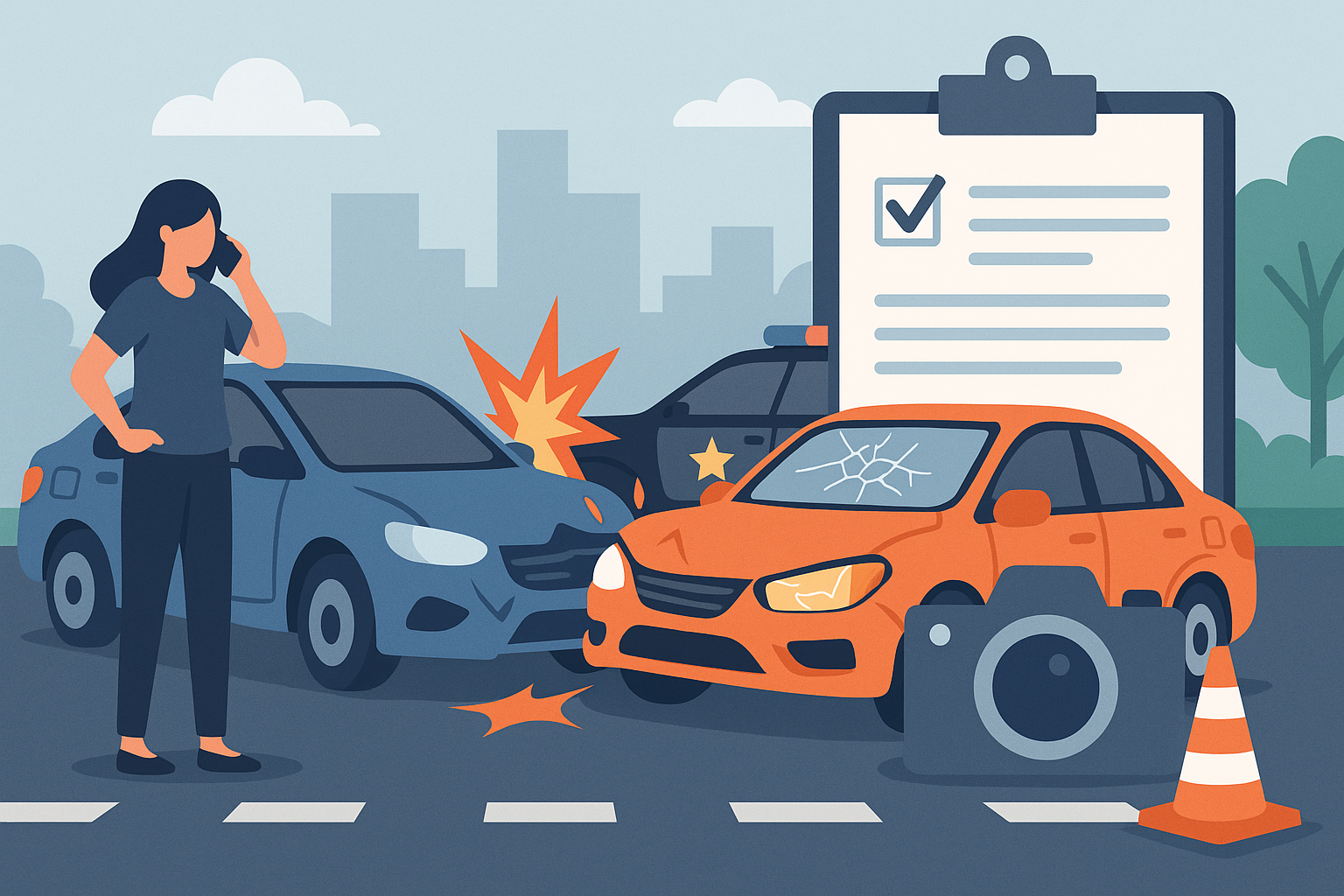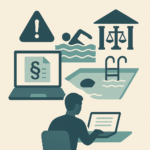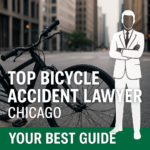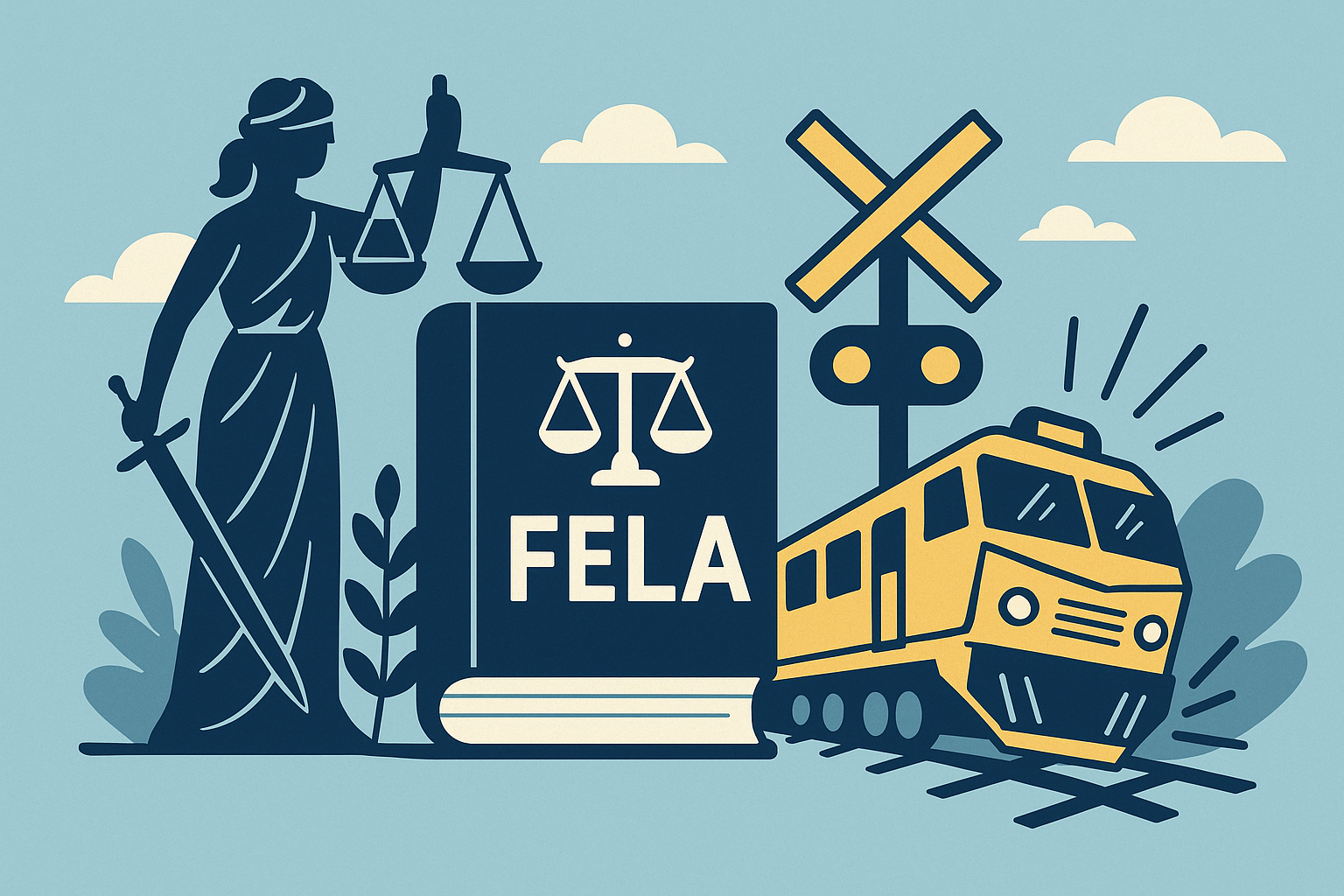Being involved in a car accident can be a nerve-wracking experience, especially when it’s not your fault. Whether you’re a driver or passenger, understanding what steps to take immediately after the incident is crucial to protect your legal and financial standing. This article will guide you through the essential actions to take after a car accident that wasn’t your fault. We’ll explore contacting the authorities, gathering evidence, notifying insurance companies, and when it’s time to consider car accident legal help. Read on to ensure you’re fully prepared to handle the aftermath of an accident efficiently and confidently.
Ensure Safety and Contact Authorities
Move to a Safe Location
After a car accident that wasn’t your fault, the top priority is ensuring your safety and minimizing potential risks. If possible, move your vehicle to a secure location, preferably the shoulder of the road or a nearby parking area. This proactive step reduces the chances of secondary accidents and helps maintain the flow of traffic, preventing additional hazards for other drivers on the road.
Statistics reveal that secondary collisions frequently occur when vehicles obstruct traffic, highlighting the significance of clearing the area promptly. Before relocating your car, take a few moments to capture the scene with photographs to document valuable evidence. However, if injuries or severe damages prevent you from moving safely, prioritize staying put and activate your hazard lights.
Accident recovery experts advise maintaining a calm demeanor and preserving safety as crucial components of your immediate response strategy, especially during a no-fault accident scenario. Taking safety precautions following an accident not only protects you but also contributes to a more organized and less chaotic environment for responding emergency personnel.
Call the Police—Even for a Minor No Fault Car Accident
What to do when a car accident is not your fault is essential knowledge, especially when it comes to calling the police and reporting the incident. This step is crucial for legal and insurance purposes, providing an official record that documents key details like the date, time, and parties involved. An objective police report serves as a neutral account of the accident, which can be invaluable if you need to support your claim for a no-fault accident.
Even in minor collisions, it’s wise to call the police and file a report. This action protects you against potential disputes where the other driver may later change their story or attempt to blame you for a car accident that wasn’t your fault. The police report acts as an impartial piece of evidence, safeguarding your rights and clarifying the situation if legal challenges arise from the not-at-fault accident.
Moreover, having a documented report may be legally required in some states, regardless of the severity of the collision. By calling the police and reporting the incident, you not only facilitate the insurance claims process but also ensure clarity and protection should any legal issues emerge from the auto accident not at fault.
Document the Scene
Take Photographs and Videos
Remember to capture the scene of the no fault accident from multiple angles, providing comprehensive detail. Take photos of all vehicles involved, showcasing the damage from various perspectives – these images can serve as crucial evidence in establishing that this was an accident not your fault.
Don’t forget to photograph license plates, registration tags, and insurance policy numbers. These visual records will streamline the claims process and provide undisputed figures in case of a no fault car accident.
Capture the surrounding conditions like road surfaces, weather, signage, and any skid marks. This contextual evidence can reinforce your account by detailing environmental factors that may have influenced the incident where you were not at fault.
Immediately document any visible injuries sustained by you or your passengers. Photographic testimony of injuries can be invaluable, ensuring your narrative remains clear and supported in a legal setting when proving you were not at fault.
For a unique perspective, consider recording a brief video walkthrough of the accident scene. Videos dynamically capture nuances like traffic flow and ambient noise, offering a clearer context than static images when demonstrating the car accident not your fault.
Collect Witness Information
Car accidents can be chaotic and overwhelming experiences, but in the aftermath of a collision that wasn’t your fault, gathering witness information is crucial. Impartial eyewitness accounts can corroborate your version of events and provide invaluable support for your claim. Witnesses offer an unbiased perspective, providing details that may reinforce your explanation and counter any arguments from the other party involved.
When collecting witness details, be sure to ask for their full name, contact information, and a brief statement or recollection of what they observed. If possible, record this information promptly, as memories can fade over time, and their account may become less precise. In some cases, witnesses may have captured video footage or photographs that can provide additional clarity, particularly in busy intersections or crowded areas.
Engaging witnesses to document their observations can significantly strengthen your case and offer leverage should legal disputes arise. Their accounts can be a decisive factor in navigating the complex questions surrounding what to do after a car accident that wasn’t your fault. Thorough documentation of witness statements can make a substantial difference in ensuring a fair outcome.
Exchange Details with the Other Driver
Exchanging crucial details with the other driver involved in a car accident not your fault is a critical first step. Calmly gather their full name, contact information, vehicle make, model, color, license plate number, and driver’s license number. Do not overlook obtaining their insurance provider’s name and policy number, as these details will expedite the claims process for the no fault accident.
While engaging with the other driver, maintain composure and refrain from admitting fault or engaging in heated discussions about the incident. To ensure transparency and accuracy, suggest taking photos of each other’s documents. This approach can be particularly helpful if the other driver appears uncooperative, as it prevents the exchange of inaccurate information.
Knowing the proper protocol for what to do after a minor car accident that is not your fault can shield you from potential financial liabilities and facilitate a smoother claims process. By exchanging necessary details at the scene, you lay the groundwork for a more efficient resolution of the no fault accident.
Notify Your Insurance Company
Provide Accurate Information
What to do after a car accident not your fault is crucial for protecting your rights and ensuring a smooth claims process. It’s essential to provide accurate information about the incident, including the date, time, and location details. An official accident report serves as a reliable reference point for all parties involved, helping prevent discrepancies and false claims or blame for the accident that wasn’t your fault.
Inaccurate or omitted details can lead to disputes that complicate legal proceedings and affect insurance settlements. Therefore, double-checking all the information you provide and requesting a copy of the accident report for your records is vital. Consider documenting verbal exchanges with witnesses or the other party using voice memos on your phone. This additional layer of accountability ensures small details do not get lost, paving the way for a less contentious claim process.
Understand How No Fault Accidents Affect Your Insurance
Understanding your car insurance coverage is vital, especially after a no fault car accident. Familiarize yourself with your policy’s nuances to know which damages and medical costs are covered under different circumstances. Comprehensive and collision coverage can assist in damages to your vehicle regardless of fault. In contrast, personal injury protection (PIP) may cover medical expenses.
An often overlooked aspect is how these coverages may also affect your premium rates in a no fault car accident. Being knowledgeable about these elements can protect you from unexpected out-of-pocket expenses. Conduct periodic reviews of your policy and discuss any ambiguities with your insurance agent.
A unique insight is to ask for a hypothetical claims walkthrough from your agent, so you can see precisely how each part of your coverage comes into play in different scenarios. This understanding ensures you’re financially equipped for what to do after a car accident that wasn’t your fault.
Seek Medical Attention
Get Checked by a Healthcare Professional
Getting checked by a healthcare professional is crucial after a car accident, even if it’s a no-fault accident and you initially feel fine. Here’s why:
- Detect Delayed Injuries: Many car accident injuries, such as whiplash, can surface later. A medical evaluation soon after the accident ensures any delayed injuries are diagnosed and treated promptly.
- Document Evidence: Medical records serve as vital documentation linking your injuries directly to the car accident. This evidence can be invaluable when filing insurance claims or pursuing legal action to ensure you receive proper compensation.
- Prevent Complications: Prompt medical attention reduces the risk of undiagnosed conditions escalating into severe health issues later on. Timely intervention can effectively address hidden problems before they worsen.
- Gain Peace of Mind: A healthcare professional’s assessment provides reassurance about your health and clarifies any doubts or concerns you might have regarding potential injuries sustained in the accident.
- Comprehensive Evaluation: Consider requesting a thorough health check, including neurological evaluations. This proactive approach ensures that even silent or seemingly minor symptoms, particularly in high-risk scenarios like rollovers or high-speed collisions, are not overlooked.
Document All Injuries
- Thoroughly document all visible injuries sustained from the no fault accident, such as bruises, cuts, and swelling, by taking photographs as soon as possible after the incident. This visual evidence effectively establishes a clear connection between the accident and your injuries.
- Maintain meticulous medical records, including doctor’s notes, treatment plans, diagnoses, and any other relevant documents. These records are crucial when pursuing claims regarding what to do after a car accident that wasn’t your fault, as they provide detailed evidence of the required medical treatment.
- Keep a consistent log documenting any changes in pain levels or the emergence of new symptoms over time. This ongoing record supports your case by illustrating the sustained impact of the injuries and their progression.
- Document any emotional or psychological effects you experience as a result of the not at fault accident. Such records can be pertinent if seeking compensation for trauma or mental anguish caused by the incident.
- Consider maintaining a personal diary detailing your recovery journey from the car accident not your fault. This intimate account not only demonstrates the day-to-day challenges faced due to the accident but also paints a comprehensive picture of your healing process, aiding in communicating both short-term and long-term effects to support your case.
Consider Legal Assistance
When to Hire a Lawyer
You should consider hiring a car accident lawyer after a car accident not your fault when the situation involves complexities that may impact your financial recovery.
One prominent scenario is if the accident results in serious injuries or devastating property damage, which insurance companies might undervalue. An attorney can effectively negotiate on your behalf to secure a fair settlement in such cases. If you’re dealing with an insurance company that attempts to deny payment, having legal representation can be pivotal in challenging these decisions.
If fault is disputed by the other party, an attorney can collect evidence and witnesses to support your case, clarifying what to do after a car accident not your fault. These professionals can provide valuable guidance if there are multiple parties involved, as these cases can be especially intricate. Their expertise ensures each party’s liability is appropriately addressed, protecting your rights and interests.
Hiring a lawyer after a car accident not your fault is advisable when facing complex situations involving severe injuries, significant property damage, insurance disputes, contested fault, or multiple parties. An attorney’s negotiation skills, evidence gathering abilities, and legal knowledge can make a substantial difference in securing fair compensation and navigating intricate legal processes.
Quick Take Aways
Key Points
- Ensure Safety and Contact Authorities: Always prioritize safety by moving to a secure location if possible, and contacting authorities to report the incident.
- Document the Scene: Take photographs and videos of the accident scene, including vehicle damage and surrounding conditions, to capture crucial evidence.
- Collect Witness Information: Gather details from witnesses to support your claim and provide an unbiased perspective of the incident.
- Exchange Details with the Other Driver: Obtain essential contact and insurance information from the other driver to facilitate a smooth claims process.
- Notify Your Insurance Company: Report the accident with precise information to avoid disputes and ensure accurate processing of your claim.
- Seek Medical Attention: Get examined by a healthcare professional to catch any delayed injuries and document them for insurance claims.
- Consider Legal Assistance: Hire a lawyer if you experience significant injury, property damage, or if fault is contested, to ensure fair compensation and protection of your rights.
Frequently Asked Questions
1. What should I do immediately after a car accident that wasn’t my fault?
If you are in a car accident that wasn’t your fault, ensure your safety first. Call the police to file an accident report, even if no one is injured. Gather evidence by taking photos of the scene, exchanging contact and insurance details with the involved parties, and collecting witness information. This documentation is crucial when dealing with an accident not your fault insurance claim.
2. How can I file an insurance claim if the car accident wasn’t my fault?
To file a successful insurance claim for a car accident that wasn’t your fault, contact your insurer as soon as possible. Provide them with the police report, photos, and other documentation you collected. Clearly explain the incident and let them handle the communication with the at-fault driver’s insurance company. This helps streamline the process for accidents where you are not at fault.
3. Should I contact a lawyer after a car accident that wasn’t my fault?
Yes, contacting a lawyer can be beneficial after a car accident that wasn’t your fault, especially if you encounter difficulties with your claim or have sustained injuries. A legal expert can help navigate the complexities of personal injury claims and ensure you receive fair compensation for your losses and suffering.
4. What expenses are typically covered when the car accident wasn’t my fault?
When a car accident wasn’t your fault, the responsible driver’s insurance should cover vehicle repairs, medical bills, rental car costs, and potentially pain and suffering depending on the case. Ensure thorough documentation to support all your claims and consult with your insurance company for specific coverage details.
5. Can my insurance rates increase if I’m involved in a car accident that wasn’t my fault?
Typically, your insurance rates shouldn’t increase if you are not at fault in a car accident. However, some insurers might raise your premium depending on overall claims experience and risk assessments. It’s advisable to check your policy terms and discuss concerns with your insurance agent to clarify how your rates may be affected by a not at fault car accident.
Know Your Next Move After an Accident That Wasn’t Your Fault — Contact Ori Law Group Today
Experiencing a car accident that wasn’t your fault can be overwhelming, but knowing what to do afterward is crucial for protecting your rights and ensuring a smooth recovery process. By following the steps outlined, you can better navigate the complexities of post-accident situations. Start by moving your vehicle to a safe location, if possible, and contacting authorities to report the incident. Don’t forget to document the scene extensively and gather witness information to support your case.
If you’ve been injured in a car accident that wasn’t your fault, don’t wait—call Ori Law Group at (312) 621-0000 to schedule a consultation.
Exchanging information with the other driver is essential for a smooth claims process. Providing accurate details to your insurance company ensures a seamless claim experience and prevents unnecessary disputes. Understanding your insurance coverage is vital, especially in a no fault accident situation, so you’re well-prepared for any financial implications.
Seeking prompt medical attention is important for identifying any delayed injuries and documenting them for legal and insurance purposes. Consider maintaining a detailed record of your injuries and recovery journey to reinforce your claims and demonstrate the impact of the accident. When necessary, engage the services of a lawyer to expertly navigate insurance negotiations, liability disputes, and achieve fair compensation.
As you move forward from the incident, prioritize protecting your legal and financial interests by keeping these steps in mind. Being proactive and informed can make all the difference in handling the aftermath of a car accident not at fault. Don’t hesitate to seek professional car accident attorney when needed, and ensure you’re equipped with the right tools to secure a favorable outcome.
References
Here are some authoritative external sources relevant to “What To Do After a Car Accident Not Your Fault”:
- National Highway Traffic Safety Administration (NHTSA): “What To Do If You’re In a Car Crash”
- Insurance Information Institute (III): “What to Do After an Auto Accident”
- American Bar Association: “What to Do After a Car Accident”
- Allstate Insurance Company: “What to Do After a Car Accident: A Step-by-Step Guide”
- Consumer Reports: “What to Do After a Car Accident”










